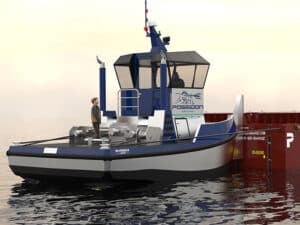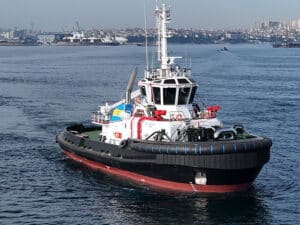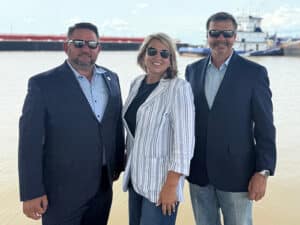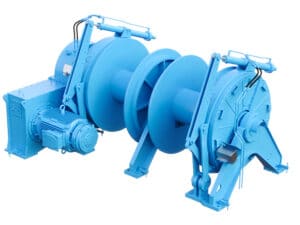
New research makes case for workboat repower grants
Written by Nick Blenkey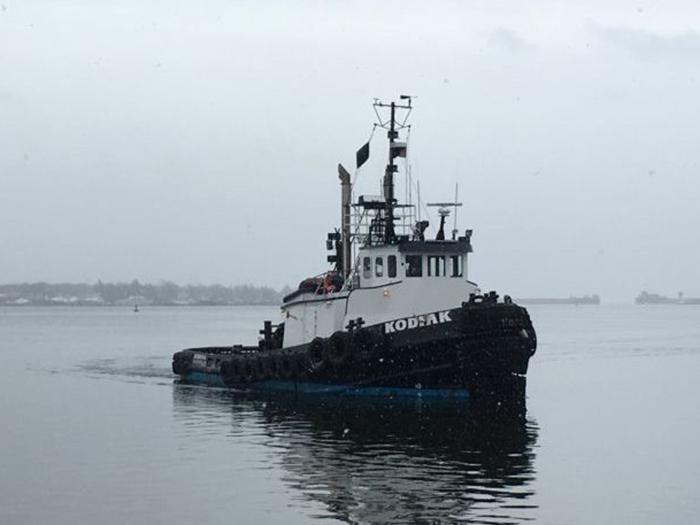
The Kodiak, a tugboat whose old diesel engines were replaced with new, cleaner engines thanks to a private-public partnership. Photo: 41 North Offshore, LLC
New research makes a powerful case for continued funding for EPA Diesel Emissions Reduction Act (DERA) grants and loans for projects that reduce emissions from existing workboat diesel engines. It also underscores the opportunities for state governments to make major air quality gains by using funds from Volkswagen’s $2.9 billion environmental mitigation trust for marine repower projects.
A study completed by Ramboll Environ for the Diesel Technology Forum (DTF) and the Environmental Defense Fund (EDF) finds that the average Category 2 workboat remains in service for 50 years, instead of the 23-year lifespan estimated by the EPA in the 2008 Heavy Duty Locomotive and Marine Rule.
“This report underscores that more, older engines remain in service today,” said Ezra Finkin, DTF Policy and Outreach Director. “Since real-world workboat engines are operating with longer lifespans, the actual nitrogen oxide emission reductions are 52 percent weaker than predicted in EPA’s 2008 Rule calculations. Replacing more of these older and longer-lived engines with the latest clean diesel models, faster, will generate significant emissions reductions.”
The EPA estimates that, as of 2014, 81 percent of Category 1 and 2 workboats used older, uncontrolled or Tier 1 diesel engines, which are 10 times higher in emissions than a modern Tier 4 diesel engine. According to the DTF-EDF report, the slow turnover rate of these technologies means communities will only see nitrogen oxide (NOx) reductions of 161,167 tons per year, well below the 333,925-ton reduction predicted in the EPA 2008 Rule. Similarly, fine particulate emissions (PM 2.5) will only be reduced by 3,537 tons per year, instead of by 8,758 tons per year.
“Most tugs are operating in locations near America’s ports which do not meet current federal health-based air quality standards,” said Dr. Elena Craft, EDF Senior Director. “This study underscores the need to increase funding for the replacement of older marine engines, reduce exposure to diesel emissions, and for EPA to update the service life assumptions used by the 2008 Rule.”
Starting in 2015, new diesel engines used in marine applications in the United States were required to meet Tier 4 emissions standards. Relative to previous generations of technology, these latest clean diesel technologies are proven to dramatically reduce emissions, including nitrogen oxides and fine particulates, by 88 percent to 95 percent compared to previous generations.
Significant Emissions Reductions Opportunity: New York and Houston Examples
Despite the widespread availability of the new, cleaner diesel engines for workboats, the cost and downtime required to upgrade are obstacles to investment in the new technology.
“If the rate of turnover to the newest generation of diesel technologies can be accelerated, near-port communities stand to reap significant air quality benefits; it’s definitely low-hanging fruit on the clean air tree,” said Allen Schaeffer, DTF Executive Director. “For example, if all existing Category 2 vessels serving the New York Harbor upgraded to the newest diesel engines, emissions in the New York metropolitan area would be cut by more than 8 tons of nitrogen oxides per day. In the Port of Houston and Galveston, more than 4 tons of nitrogen oxides reductions per day could be realized for the Houston metropolitan area.”
DTF and EDF say that state governments have an opportunity right now to replace old work boat engines with new ones, delivering significant and immediate emission reductions for surrounding communities, long before many other options. States can use funds from Volkswagen’s $2.9 billion environmental mitigation trust for marine repower projects.
A related study by DTF and EDF confirms that upgrading workboats to the newest-model clean diesel engines delivers the greatest emissions improvements for the lowest cost. Commercial marine engine upgrade or repower projects are very cost-effective owing to high engine rated power, hours of operation, engine load, and long service life. On average, upgrading the engines of a single tugboat to the newest diesel technologies eliminates 14.9 tons of nitrogen oxide emissions per year for only $4,379 per ton of nitrogen oxide eliminated. Compare this to the cost of many other types of nitrogen oxide -reduction projects: more than $30,000 per ton of nitrogen oxide.
“Large engine repowers are more than six times as cost effective on a dollar-per-ton-of-emissions-reduced basis than other projects, which should make for an easy and compelling choice for states in ozone non-attainment,” said Schaeffer. “The incentive funds give boat operators a brand new, more efficient, fuel-saving and lower-emitting engine at a fraction of the cost. Even better, the emission benefits associated with these projects will accrue quickly and persist for many years.”
KODIAK REPOWER
One recently completed repower saw another group that is active in this sphere, the Conservation Law Foundation (CLF) awarded an EPA DERA grant partner with New Bedford company, 41° North, to pay for three new engines on its tugboat, the Kodiak. The total cost to replace these engines is more than $1 million, but EPA is providing around half of the total engine replacement cost, while 41° North will cover the remainder.
Swapping out the engines will help the tugboat run more efficiently, helping the boat owner stay competitive. in an industry with thin business margins.
This is CLF’s sixth DERA grant since 2011, with each grant retrofitting a boat.

